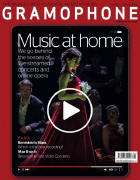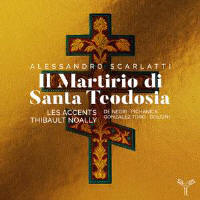Texte paru dans: / Appeared in:
|
|
|
Outil de traduction (Très approximatif) |
|
|
Reviewer:
Richard Wigmore Reflecting contemporary iconography, female saints, virgins and martyrs were irresistible subjects for Italian Baroque composers. Alessandro Scarlatti wrote four such oratorios, beginning with Il martirio de Santa Teodosia, possibly commissioned by a Roman patron in 1683 and certainly performed in Modena two years later. In the original sources the teenaged Theodosia of Tyre travelled from her native Lebanon to the city of Caesarea in Palestine, where she comforted Christian prisoners awaiting execution. For her pains she was arrested, thrown to wild beasts and hurled into the sea, only to keep reappearing until the Roman governor Urbanus ordered her decapitation. The (anonymous) libretto set by Scarlatti duly softens the original for refined aristocratic consumption. The focus in the first half of the story is on the unrequited love of the governor’s son Arsenius for Theodosia. His confidant Decius tries to intercede on his behalf. Later Arsenius attempts to prevent Theodosia’s death, but to no avail: she is determined to die a martyr and be blissfully united with God. A soberly fugal final coro points the moral: ‘For one who dies for God, death is life.’ You’ll look in vain here for the colour and harmonic daring of such later Scarlatti oratorios as Cain, overo Il primo omicidio. But there is plenty to relish in Il martirio de Santa Teodosia, cast in a style somewhere between the Italian oratorios of Carissimi and Handel. Arias tend to be short and strophic, recitative often flowers into arioso. There are songs of gentle longing for Arsenius, brief, vivid ensembles of confrontation, a tumultuous ‘rage’ aria for Urbanus and a jaunty song with solo violin for Decius. Theodosia herself – by far the largest role – has the two most substantial and poignant arias, one at the end of each part. Unfolding over a chromatically descending ground bass, her final ‘Spirti beati’ evokes Dido’s Lament, composed within a year or two of Scarlatti’s oratorio. Emmanuelle de Negri sings this with a fragile, haunted tone apt to the mortally wounded heroine. Elsewhere she brings both grace and passion to a role that ranges from contemplative ecstasy (say, in the plaintive, Purcellian ‘Mi piace il morire’) to the fiery resolve of ‘All’armi ò costanza’. In song and recitative her words always tell. Her colleagues, all good Baroque stylists, make worthy partners. The tenor Emiliano Gonzalez Toro brings a tenderly rounded tone to the role of the unhappy Arsenius. Renato Dolcini is formidable without bluster as Urbanus, while Anthéa Pichanick, with her androgynous contralto (you could easily mistake her for a countertenor), impresses as the ever-optimistic Decius. Bass lines sometimes seem over-weighted, especially in slower numbers. This proviso apart, Thibault Noally directs with dramatic flair and secures crisp, thoroughly idiomatic playing from his expert period ensemble. No one with a taste for Baroque oratorio need hold back. |
|




